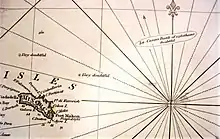Vigia (nautical)
A vigia is a warning on a nautical chart indicating a possible rock, shoal, or other hazard which has been reported but not yet verified or surveyed.[2][3]

Some non-existent vigias have remained on successive charts for centuries as a precaution by hesitant hydrographers. One such example was 'Las Casses Bank', a vigia between Menorca and Sardinia in the Mediterranean Sea which first appeared on charts in 1373 and remained on some charts as late as 1852.[1]
Another notable false vigia was 'Aitkins' Rock' off the northwest coast of Ireland, first reported in 1740 with six further reports over the following eighty years the supposed rock was blamed for numerous lost ships. Surveys by the Royal Navy in 1824, 1827, and 1829 failed to locate the rock, until a final extensive six week survey in 1840 using two brigs led to the conclusion that the rock had never existed. Captain Alexander Thomas Emeric Vidal, who led the final survey, noted that such false sightings were likely due to floating debris or whales.[4][5]
The term vigia is derived from the Spanish vigía or Portuguese vigia, from the Latin vigilia.[6]
See also
- Phantom islands – Island recorded on maps but later proven nonexistent
- Terra incognita – "Unknown land", area not mapped by cartographers
References
- Campbell, Tony; Barritt, Michael (December 2020). "The Representation of Navigational Hazards: The Development of Toponymy and Symbology on Portolan Charts from the 13th Century onwards" (PDF). The Journal of the Hakluyt Society. London: The Hakluyt Society: 13–15. ISSN 2051-543X. Archived (PDF) from the original on 20 January 2021. Retrieved 22 February 2021.
- Dear, I.C.B.; Kemp, Peter, eds. (2007), "vigia", The Oxford Companion to Ships and the Sea, Oxford University Press, doi:10.1093/acref/9780199205684.001.0001, ISBN 978-0-19-920568-4, archived from the original on 23 July 2022, retrieved 22 February 2021
- "Glossary of Marine Terms". Digimap. University of Edinburgh. Archived from the original on 16 August 2017. Retrieved 22 February 2021.
- Alexander Thomas Emeric, Vidal (1831). "On the Vigia called the Aitkins' Rock". Journal of the Royal Geographical Society of London (2nd ed.). Royal Geographical Society of London. 1st: 51–57. Archived from the original on 2022-07-23. Retrieved 2021-02-22 – via Wikisource.
- Dawson, Llewellyn Styles (1885). "Vice-Admiral A. T. E. Vidal, R. N.". Memoirs of hydrography, including brief biographies of the principal officers who have served in H.M. Naval Surveying Service between the years 1750 and 1885;. London: Eastbourne: Henry W. Keay. pp. 94–95 – via Archive.org.
- "vigia, n." OED Online. Oxford University Press. Archived from the original on 23 July 2022. Retrieved 22 February 2021.